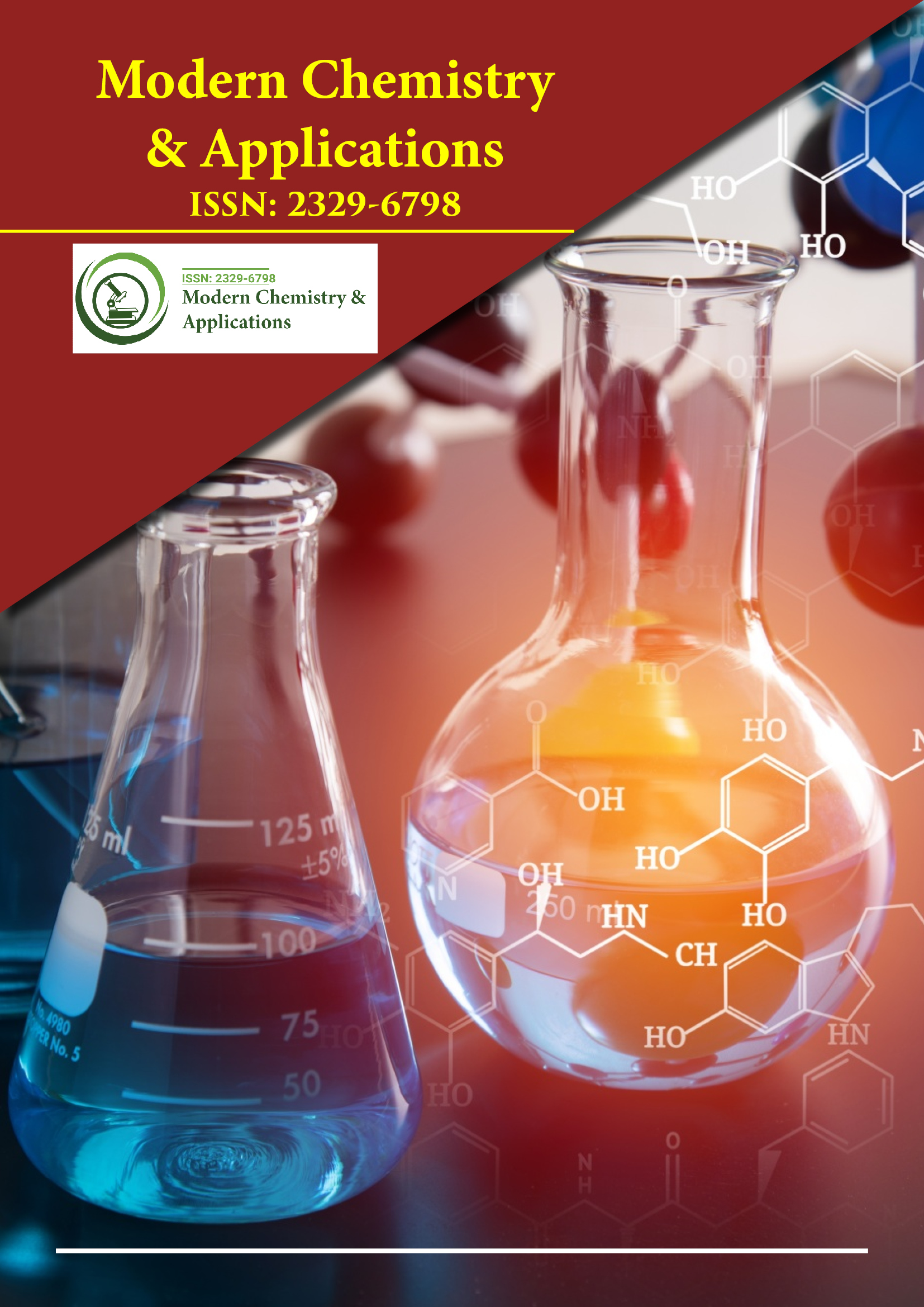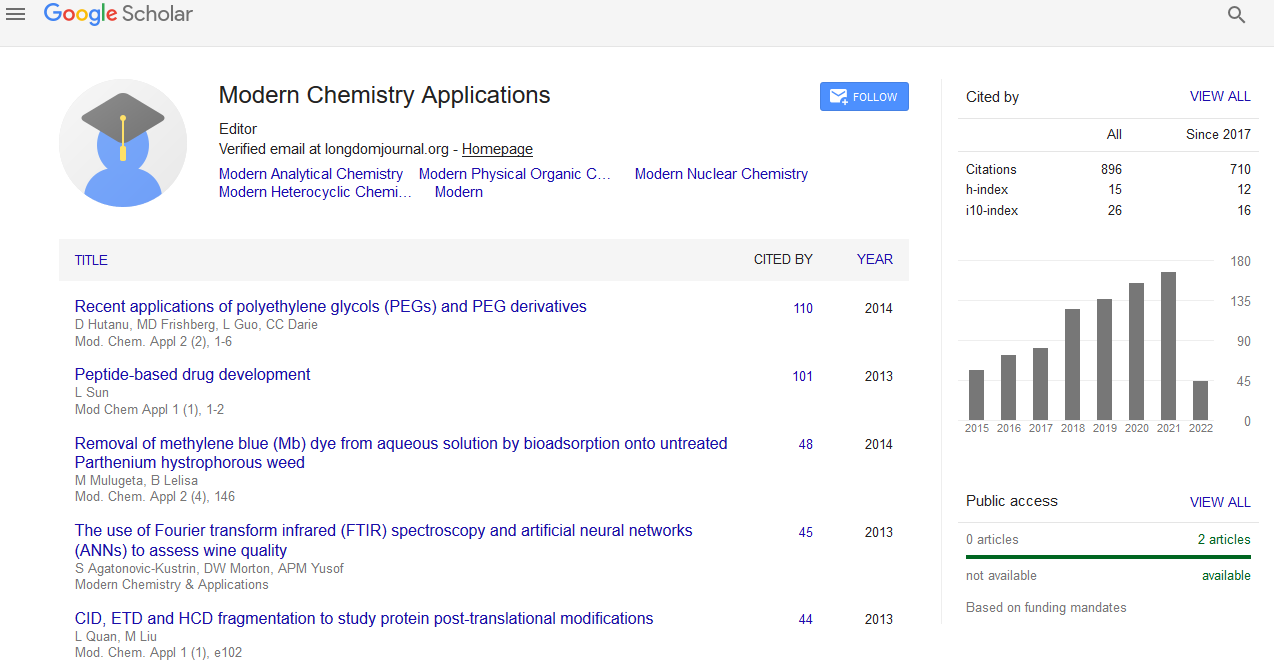Indexed In
- Open J Gate
- JournalTOCs
- RefSeek
- Hamdard University
- EBSCO A-Z
- OCLC- WorldCat
- Scholarsteer
- Publons
- Geneva Foundation for Medical Education and Research
- Google Scholar
Useful Links
Share This Page
Journal Flyer

Open Access Journals
- Agri and Aquaculture
- Biochemistry
- Bioinformatics & Systems Biology
- Business & Management
- Chemistry
- Clinical Sciences
- Engineering
- Food & Nutrition
- General Science
- Genetics & Molecular Biology
- Immunology & Microbiology
- Medical Sciences
- Neuroscience & Psychology
- Nursing & Health Care
- Pharmaceutical Sciences
Short Communication - (2024) Volume 12, Issue 2
Modern Cancer Treatment: The Synthesis of Antitumor Heterocyclic Compounds
Mohammed Hamzah*Received: 01-May-2024, Manuscript No. MCA-24-25784; Editor assigned: 03-May-2024, Pre QC No. MCA-24-25784 (PQ); Reviewed: 17-May-2024, QC No. MCA-24-25784; Revised: 24-May-2024, Manuscript No. MCA-24-25784 (R); Published: 31-May-2024, DOI: 10.35248/ 2329-6798.24.12.463
Description
Heterocyclic compounds, characterized by rings containing at least one atom other than carbon, are a cornerstone of medicinal chemistry. The synthesis of novel heterocyclic compounds with antitumor activity represents a dynamic and crucial area of research in the quest to develop new cancer treatments. Given the complexity and variability of cancer cells, these compounds offer a promising avenue due to their diverse structures and ability to interact with multiple biological targets. This article explores the synthesis, mechanisms of action, and potential applications of novel heterocyclic compounds in cancer therapy.
Heterocyclic compounds
Heterocyclic compounds are organic molecules that contain rings with at least one heteroatom such as nitrogen, oxygen, or sulfur. These compounds are prevalent in numerous natural products, pharmaceuticals, and agrochemicals due to their wide range of biological activities. In the context of antitumor activity, heterocyclic compounds have gained significant attention for their ability to interfere with various cellular processes involved in cancer progression.
Synthesis of novel heterocyclic compounds
The synthesis of heterocyclic compounds can be achieved through various methods, including traditional organic synthesis, metal-catalysed reactions, and modern techniques such as microwave-assisted synthesis and green chemistry approaches. Traditional organic synthesis methods, including cyclization reactions and condensation reactions, have been fundamental in the creation of heterocyclic compounds. For instance, the Hantzsch synthesis is a classic method for producing pyridine derivatives, which have shown potential antitumor activity. Metal-catalysed reactions, such as palladium-catalysed cross- coupling reactions, have revolutionized the synthesis of heterocyclic compounds. These reactions enable the formation of complex structures with high precision and efficiency. An example is the Suzuki-Miyaura coupling, which can be used to synthesize heterocyclic structures with potential antitumor properties. Microwave-assisted synthesis is a modern technique that accelerates chemical reactions, reducing reaction times and improving yields. This method is particularly useful for synthesizing heterocyclic compounds, allowing for rapid screening of potential antitumor agents. Green chemistry approaches aim to minimize environmental impact by using sustainable practices. Solvent-free reactions, use of water as a solvent, and employing recyclable catalysts are some of the green strategies that have been applied in the synthesis of heterocyclic compounds.
Mechanisms of antitumor activity
Heterocyclic compounds exhibit antitumor activity through various mechanisms, targeting different aspects of cancer cell growth and survival.
DNA intercalation and inhibition of topoisomerases: Some heterocyclic compounds intercalate into DNA, disrupting the replication and transcription processes essential for cancer cell proliferation. Others inhibit topoisomerases, enzymes that modulate DNA topology during replication. Quinoline and isoquinoline derivatives are examples of heterocycles that act through these mechanisms.
Inhibition of protein pinases: Protein kinases are enzymes that regulate various cellular processes, including growth and division. Heterocyclic compounds, such as pyrimidine and purine derivatives, can inhibit these enzymes, disrupting signaling pathways critical for cancer cell survival.
Induction of apoptosis: Many heterocyclic compounds induce apoptosis, or programmed cell death, in cancer cells. This process can be triggered through intrinsic or extrinsic pathways, leading to the activation of caspases and subsequent cell death. Indole derivatives are known for their ability to induce apoptosis in tumor cells.
Potential applications and future directions
The development of novel heterocyclic compounds with antitumor activity holds great promise for advancing cancer therapy. These compounds can be used as standalone treatments or in combination with existing therapies to enhance efficacy and reduce resistance. Targeted therapy involves using compounds that specifically target cancer cells while sparing normal cells. Heterocyclic compounds designed to inhibit specific molecular targets associated with cancer can provide a more selective and effective treatment option. Combining heterocyclic compounds with other therapeutic agents can enhance treatment outcomes. For instance, combining DNA intercalating agents with protein kinase inhibitors can target multiple pathways simultaneously, reducing the likelihood of resistance. Drug resistance is a major challenge in cancer treatment. Heterocyclic compounds with novel mechanisms of action can help overcome resistance by targeting pathways that are not affected by traditional chemotherapeutic agents. Personalized Medicine Advancements in genomics and molecular biology enable the development of personalized medicine approaches, where heterocyclic compounds can be tailored to the genetic profile of individual tumors. This strategy can maximize therapeutic efficacy and minimize side effects.
Conclusion
The synthesis of novel heterocyclic compounds with antitumor activity is a vibrant and critical area of research in medicinal chemistry. By leveraging traditional and modern synthetic methods, researchers can create diverse and potent compounds that target various mechanisms of cancer cell survival and proliferation. As our understanding of cancer biology continues to evolve, the development of these compounds will play a pivotal role in advancing cancer therapy, offering new hope for effective and targeted treatments. The integration of these novel compounds into clinical practice will require ongoing research, rigorous testing, and collaboration across scientific disciplines to overcome the challenges of cancer treatment and improve patient outcomes.
Citation: Hamzah M (2024) Modern Cancer Treatment: The Synthesis of Antitumor Heterocyclic Compounds. Modern Chem Appl. 12:463.
Copyright: © 2024 Hamzah M. This is an open access article distributed under the terms of the Creative Commons Attribution License, which permits unrestricted use, distribution, and reproduction in any medium, provided the original author and source are credited.


